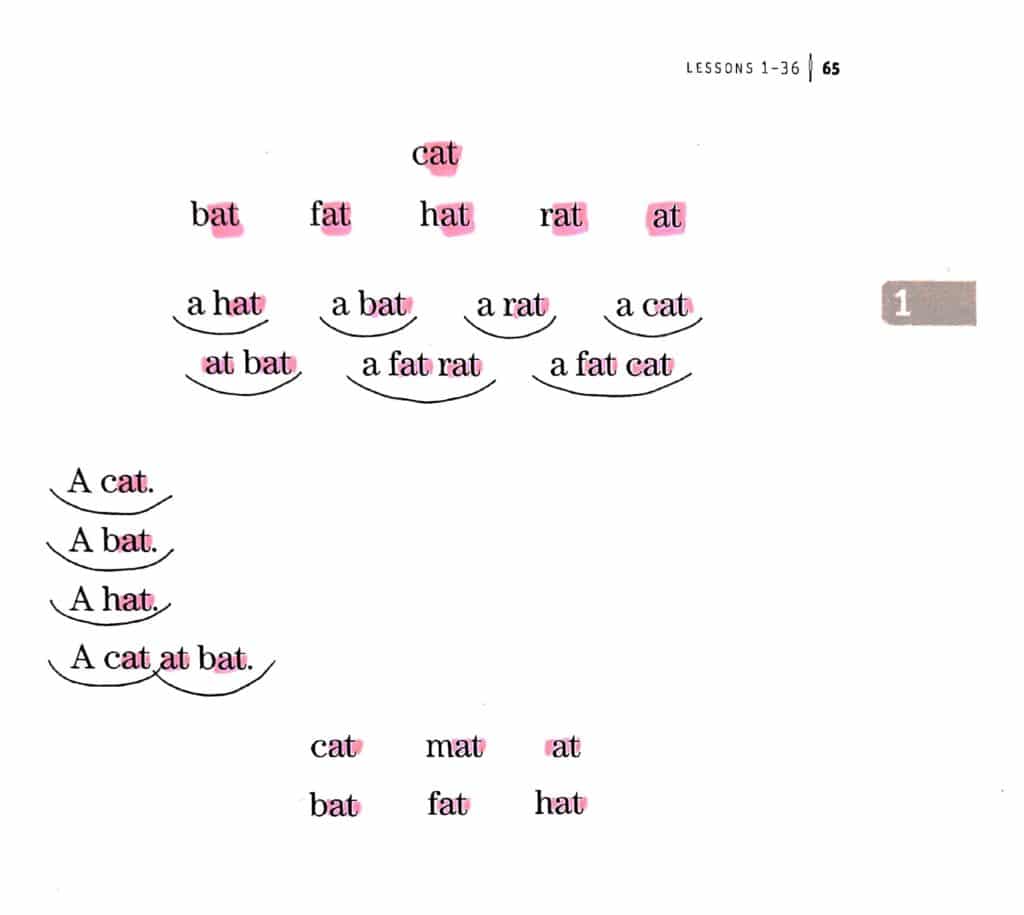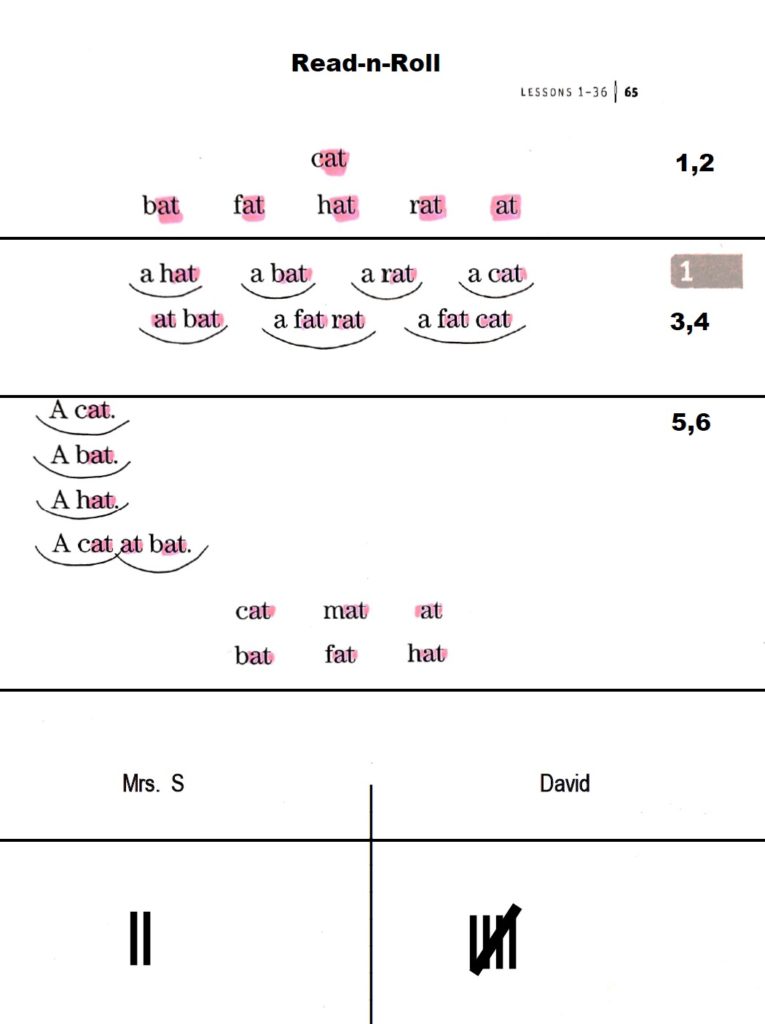Introducing Let’s Read
Develop reading fluency using a linguistics (word families) approach and controlled text
What is reading fluency?
Reading fluency may be defined as reading:
- accurately,
- automatically (smoothly and easily),
- in phrases,
- with expression,
- at an age-appropriate speed.
A fluent reader decodes (reads) so automatically that their mind is free to focus on the message in the reading material. Let’s Read is a program that can incrementally, systematically develop reading skills.
Linguistic Approach
A word family is a group of words that have a common rime unit. The rime unit of a word is the vowel plus any letters that follow at the end of a word. For example, the rime unit of the word family c-at, h-at, f-at, s-at is “at” (vowel A + T). A linguistic approach to developing reading skills is based on rime units and word families.
Let’s Read is a simple and systematic linguistic approach to building reading skills. As with typical phonics readers, Let’s Read relies on phonics decoding skills to read, but, contrary to regular phonics readers, its friendly word family (linguistic) approach is less demanding than regular phonics readers.
Word families rhyme and rhyming word families are great building blocks for reading fluency. The brain stores the sounds of a word in its memory bank for later recall when reading and rhyming words are stored and recalled more easily.
I was excited when I learned of Let’s Read in July 2020. It is the most complete and thorough linguistics approach program I have seen. It is my pleasure to recommend it to parents and teachers alike for reading skill development and reading fluency. I believe it is an excellent choice for building confidence and reading fluency in budding readers in a simple, systematic way. I introduce it to my students during Barton Level 2, after they have completed Foundation in Sounds and Barton Reading and Spelling System Level 1. After Barton Level 2, students have the skills to read independently all of the words in Part 1 of Let’s Read. Part 2 of Let’s Read correlates with Barton Level 3.
Controlled Text
Controlled Text is text that matches a student’s reading level.
Students are able to read each word independently – without pictures and without guessing – because the words used are controlled, or restricted, to words they can sound out based on concepts they have learned or words they have memorized as sight words.
Let’s Read presents its text systematically, sequentially, in a gradual progression from rime unit to rime unit, which is great for building confidence and giving students a successful start to reading.
There are 6 parts to Let’s Read. Each part builds on the previous part, with increasingly complex spelling patterns introduced in each part. The 36 lessons in Part 1 are based on Consonant-Vowel-Consonant (CVC) spelling pattern using simple Vowel-Consonant (VC) rimes. Lesson 1 begins with the rime “at.”
Multi-syllable CVC/CVC words are introduced in Part 1, for example, “sunset.” Students do not find this overwhelming because they recognize the CVC pattern and learn to read the word syllable by syllable.
The book is simple and straightforward to use. The only expectation before beginning Let’s Read is that the student can identify the first sounds of all of the letters of the alphabet and knows the difference between vowels and consonants. Only the short vowel sounds are practiced in Part 1: A as in apple, E as in Eddy, I as in itchy, O as in olive, and U as in upper.
Prepare to use Let’s Read
- The word lists need to be read in columns not in rows. The rule discovery works much better that way. For example, the correct reading for the word list at the bottom of Lesson 3: pad pan, sat sad, fad fat, pad pat, ad at. The rule: change the rime to change the word or change the end consonant to change the word.
- Phrasing and Highlighting is a practice which I personally have found to be especially helpful to students. A phrase is a word or a group of words that act as unit and express a single idea but do not form a complete sentence. Basic phrases in Part 1, Let’s Read are: who – did what – where – extra/ add-on. The ability to read in phrases is vital to comprehension, but reading in phrases can be extremely challenging for students. Oftentimes, reading in phrases does not come naturally even for students who have strong oral communication skills. Follow these simple marking rules to enhance the development of reading skills for your student in Part 1:
- Mark the phrasing with an arc beneath each phrase, so that the student can focus their energy on reading. Have the student follow the phrasing with their finger as they read.


- I provide a photocopy to my students of all of the lessons in Let’s Read, Part 1, with all of the phrases marked. If you are not my student, email me proof of purchase of the book and I will gladly provide you with a PDF of Let’s Read, Part 1, with all of the phrases marked.. Each parent/teacher should purchase their own copy of Let’s Read. Please respect copyright laws and only provide the marked copies to your students.
- As illustrated below, highlight the rime units in pink for added emphasis for students who have difficulty easily recognizing the pattern. I recommend pink because science tells us that red letters on white background provides the best learning experience. Highlighters aren’t available in red, hence the pink highlighting. Alternately, the rimes could be boxed in red.

- Placing the lessons of Let’s Read into plastic page protectors has a couple of advantages. Instead of just using their finger, a student can use a whiteboard marker to follow the phrases in the lesson. The splash of colour and smooth flow of the marker adds variety to the phrase marking. Plastic page protectors are also helpful for marking the sections and keeping score for the Read-n-Roll game described below.
- Alternatively, a temporary page protector can be devised by slicing open the bottom edge of a page protector and slipping it over the page.
Teaching Sequence
- Example: Lesson 1. (The word at the top of the page is “cat.”) Explain what a rime unit is: “Before we begin reading, let’s talk about rime units. A rime unit is from the vowel to the end of the word. What is the vowel in this word? What sound have we learned for A? (Provide the answers if the student is confused or incorrect. The vowel is “A” and the vowel sound is the short a, as in apple.
- Point to each word and ask the student to read it. If they can read it, great! If not, read it to them and ask them to repeat it.
- Next repeat reading the vocabulary words at the top of the page in any order until the pupil can read them all easily, spelling only those words that are a problem. The connected reading (phrases and sentences) and word list at the bottom also serve this purpose.
- Have the student read the connected reading aloud spelling only those words he or she cannot read. The connected reading serves as review of vocabulary previously learned and provides practice for reading in phrases, with expression. Ask the student to read the phrases and sentences until fluency is achieved – accurate, automatic, (smooth and even), in phrases, with expression, at a reasonable speed for their reading level.
- Read Three Strategies for Developing Reading Fluency (below) for additional suggests to support your student.
- There is no prescribed number of times a student should read each lesson. A student should simply read each lesson until fluency is achieved – be it 1X or 10X.
- Avoid setting a particular goal for what the pupil should accomplish during a lesson. However, be sure to accomplish something during each session-even on a bad day. Focus on the positive by emphasizing how many words they correctly read and then suggest taking another look at a couple (or few) of them. Shoot for a higher number correct in subsequent readings.
- Ask students to identify the rime unit in each lesson.
Games for Let’s Read
I have built games for every level of Let’s Read, Part 1, and will post them to my website as time permits. The games are free of charge. Otherwise, if you are interested, I heartily recommend Wordwall as a game-building site https://wordwall.net/
 Alternatively, Read-n-Roll is a simple, fun game a parent or teacher can play with a student. The only material required is Let’s Read and a die numbered 1-6. Add a bit of pizzazz by using an extra large foam die or having one large die each.
Alternatively, Read-n-Roll is a simple, fun game a parent or teacher can play with a student. The only material required is Let’s Read and a die numbered 1-6. Add a bit of pizzazz by using an extra large foam die or having one large die each.
Divide the lesson into three parts. Designate each part 1-2, 3-4, and 5-6, (From personal experience, I found this more effective and efficient than dividing the lesson into 6 parts).

Take turns rolling the die. Each player reads the portion that corresponds to the number rolled. Points are earned according to number displayed on the die when rolled. Use a simple tally system to keep score.
Set a limit of 3 readings of each portion per player. This has the advantage of preventing a player from rolling the same number four times and having to read the same portion four times instead of getting equal reading practice of each part. If a player’s limit has been reached for a specific portion, then the player gets the points rolled but chooses a portion to read whose limit has not been reached.
A fun element of your choosing can be added to the game. In addition to the reading and points, rolling a “5” could also mean that the player who rolled the die has to do 5 jumping jacks and rolling a “2” could mean the opposing player must act out a “Simon Says” action dictated by the player rolled the die.
Read ‘n Roll is an excellent example of Modelled Reading, also known as Echo Reading, a proven strategy for teaching students how to read skilfully.
Three Strategies to Develop Reading Fluency
There are three strategies which I recommend for students who struggle to read smoothly, evenly, in phrases, with expression, at a reasonable rate: neurological impress method, choral reading, and echo reading. These methods provide a positive learning environment for students by taking the stress and anxiety out of reading by turning it into a shared experience. Students begin to hear themselves sound like fluent, confident readers and this builds their confidence. The three methods are simple, yet effective.
Neurological Impress Method (NIM)
- Created by Hecklman in 1969
- Hecklman believed that the best way to help struggling readers was to expose them to accurate and fluid reading, which would help them develop a more fluid reading technique. He believed that reading along with a more fluent reader acted as “an impress, an etching in of word memories on the natural process” (Heckelman, 1969).
- Neurological Impress Method is an approach of teaching reading where the teacher and student read together while tracking the words. NIM is a non-threatening multi-sensory technique that provides positive reinforcement as it engages the student. The method requires concentration and effort but it helps students remember words.
Procedure:
- The teacher and the student read aloud simultaneously from the same book.
- The reading material is at the instructional or independent level of the student.
- The teacher usually sits next to the student and focuses his or her voice close to the student’s ear
- The student is seated slightly ahead of the teacher, usually to the left of the teacher.
- The student uses the teacher’s voice as a guide.
- The teacher reads the text in the student’s ear along with the student.
- The teacher reads slightly faster and louder than the student to keep the reading fluent.
- The teacher will gradually release the lead and speak more quietly as the student gains confidence.
- It is important for the teacher to read naturally, with fluency – reading smoothly and evenly, in phrases, with expression and precise pronunciation.
- The teacher and student both track the spoken words; they move their fingers under the spoken words. This helps to train the eye to sweep across the page as the student moves their finger along with a voice that is synchronized with the words.
- Time: short, frequent intervals. 3-4X per week, two to four times per session, 5-15 minutes per session, over several months
- Never correct the student’s misread words, teach them, or ask questions! The focus is on fluency and making a voice print match.
- At the beginning, do not focus on asking the student comprehension questions after the reading. Remember, the goal is to train the eye to sweep across the page.
- Be sure to encourage your student. Compliment them on their effort. Thank them for their enthusiasm.
- (not reading in phrases!)
- Example of Neurological Impress Method
- This approach can also be practiced with audio books as demonstrated in this video beginning at the 3.10 minute mark. Example of NIM using an audio book
- A teacher/student example is presented at the beginning of the video but I don’t recommend it because the teacher reads unnaturally, in a robotic, word by word fashion instead of reading in phrases with expression. That is not the reading style or experience I want to model for my students.
Choral and Modelled Reading
Choral and Modelled Reading also focus on developing reading fluency, but with fewer explicit steps than the Neurological Impress Method.
Modelled Reading
Modelled Reading is also known as Echo Reading because students echo what their tutor reads. The tutor reads a section of the text and then invites their student to reread the section aloud. The tutor explicitly models or demonstrates the process of reading by reading the text out loud fluently – accurately, automatically (smoothly and evenly), in phrases, with expression, at a reasonable rate. The obvious enjoyment and interest the tutor displays in reading helps to captivate students’ interest and stimulate a personal interest in reading.
Choral Reading
For Choral Reading, the teacher either reads the section first and then reads it with their student or the student and teacher read the selection simultaneously from the start.
With both choral and echo reading methods, the tutor should listen for and assess correct pronunciation and fluency.
